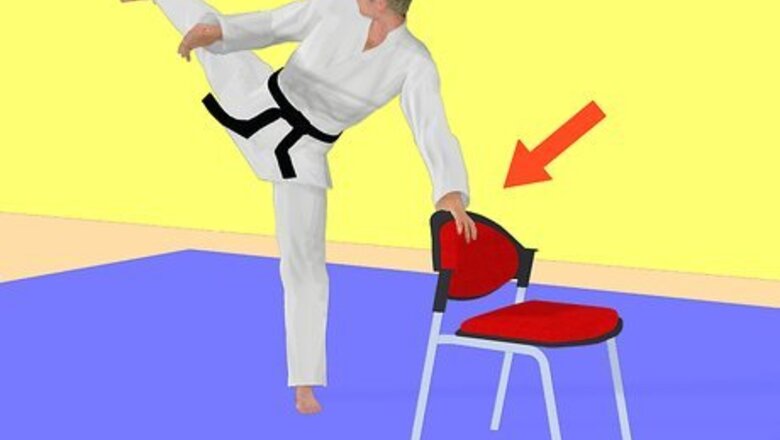
views
Doing a Regular Side Kick in Taekwondo

Hold on to a chair or wall for balance. You should practice your side kick step by step to ensure you are using the correct technique. Hold on to a chair or wall to help you balance while learning the motion of your kicking foot.

Stand sideways to the target and lift the knee of your front leg. Your ankle should be flexed and the blade of your foot should be ready to strike. The blade of your foot is the outside edge, which you will use to strike your target. When you lift your knee you should be pointing your heel at the target. Although you would normally turn your body sideways during the side kick, for now you should start sideways to practice the motion of the kicking foot only. This is a straight kick so you must have your heel pointing at the target before straightening your leg.
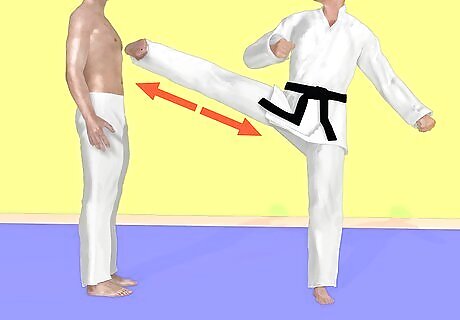
Drive your knee out towards your target and extend fully. Straighten your leg and bring your foot to the body height of the opponent. You should try to get as much of your sole facing the ground as possible so think of your big toe lifting up and your little toes pointing down. You will always strike with the blade of your foot for this strike so make sure you remember this. Aim to the body of your opponent. Make sure that your heel is higher than your toes when striking.
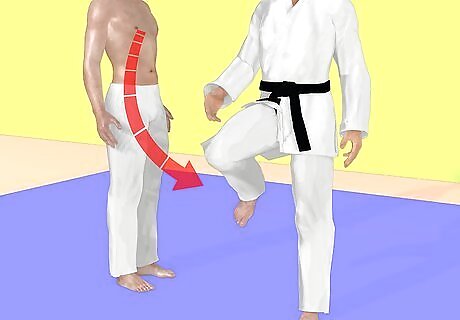
Bend your knee again and then place it on the ground. Bend the knee back to its original position before bringing your leg down to the ground.
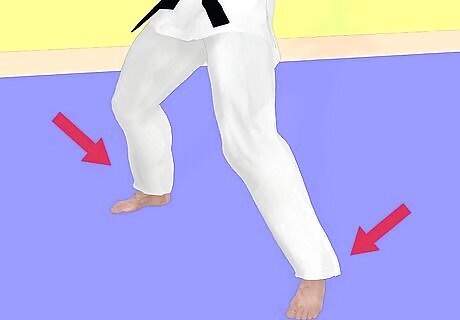
Work on your standing foot. Now that you have practiced the motion of the kicking foot, you will add the motion of the standing foot. The standing foot is key to your side kick and is extremely important for generating power and maintaining balance. Pay very close attention to the movement of this foot.
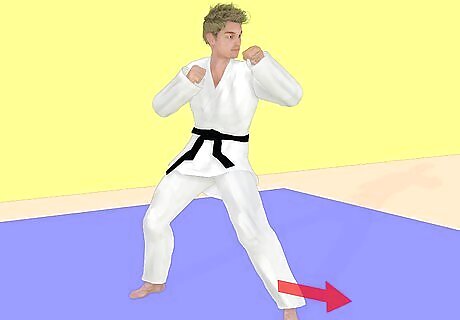
Start with your standing foot pointed forward at your target. Start from your normal fighting stance. A common fighting stance is to stand with your left foot in front and right foot in back facing mostly sideways. Your right hand would be by your chin with your left 12-16 inches (30-40 cm) in front of your left shoulder.
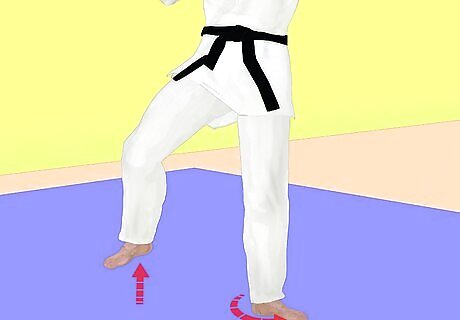
Begin rotating your standing foot as you start lifting your kicking knee. Your foot should rotate through 180 degrees during the entire side kick. This means that by the time you strike your target your standing foot will be pointing backwards.

Rotate your foot to open up your hips and generate power. Rotating your foot all the way around will open up your hips so that your foot can strike the target at the correct position. This rotation also provides the power of the side kick. You can push off your foot as it turns so that you can use your strong hip, bum and core muscles to drive your kicking foot out at your target. This rotation means you turn power from the ground into the power going forward in the kick, making the kick stronger and harder. As a beginner you can rotate your foot before straightening your knee to strike your target. As you progress make sure you are rotating your foot at the very end of your strike (when your knee is almost straightened) so that you rotate your hip into the kick. This generates more power and strength.

Keep your knee up at all times. Your knee should be in the same position from when you first bring it up, through making contact with your foot and while bringing your foot back to your body. For example, if you bring your knee to waist height at first it should stay at waist height when you make contact with the target and while you bring your foot back to your body. Dropping your knee will cause a loss of power and will prevent your kick from going horizontally through the target.
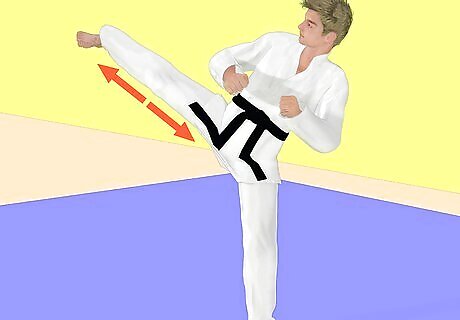
Stretch out your foot and make contact with the blade of your foot. Straighten your knee, bringing the blade of your foot into contact with the target. Be sure you use the same technique as earlier, where you flexed your foot to keep your sole facing the ground as much as possible.
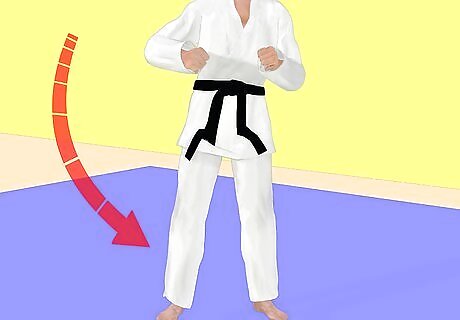
Finish your kick and bring your foot back down. Bend your knee again and then bring your foot down to the ground. You should be turned sideways when you land back on the ground. Your non-kicking foot will rotate back about 90 degrees to point in the direction you are facing.
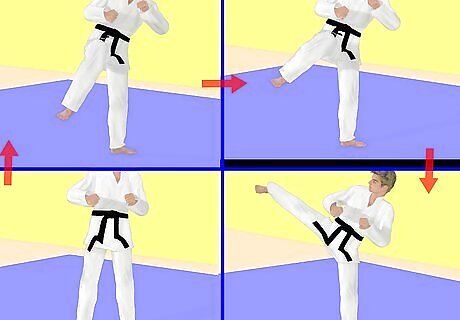
Practice your side kick often. Keep practicing to make sure you retain balance and generate maximum power by rotating and using proper technique. You should also work on your hip mobility and hip strength in order to improve your side kick.
Doing a Skipping Side Kick in Taekwondo
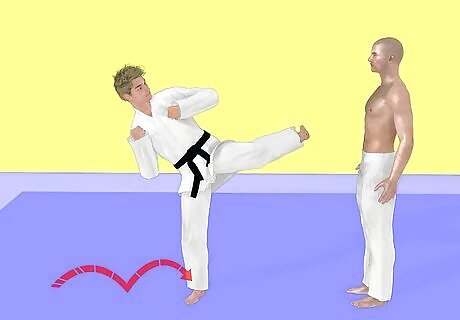
Use the skipping side kick to bring you closer to your target for the side kick. The skipping side kick is used to bring you in range of your target so that you can make contact with the side kick. This kick is also called the hop step side kick. You should master the normal side kick before attempting the skipping side kick.
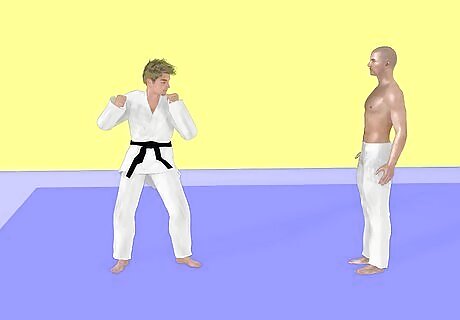
Start from your normal fighting position. You will usually begin from this position so it is best to practice from here. A common position is to stand with your left foot in front and right in back facing mostly sideways. Your right hand would be by your chin with your left 12-16 inches (30-40 cm) in front of your left shoulder.
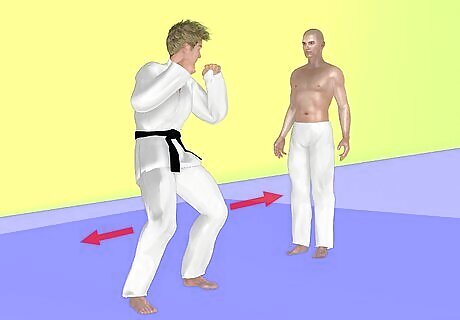
Turn your feet and body completely sideways. This gives you an advantage when you move forward into your kick later. Keep your knees bent so that you can move easily from this position.
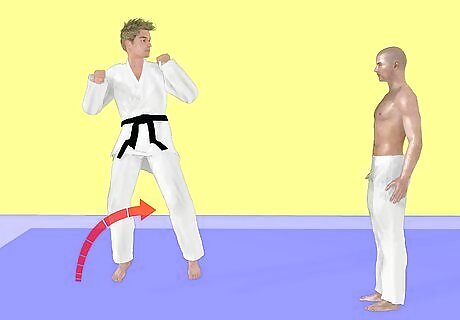
Jump up and forward at the same time. This is the “hop” or “skip” or the skipping side kick. Move forwards toward your target as you jump. You should be jumping off both feet at the same time. You will not be jumping in a huge leap forward. You will just be jumping to bring your body and leg to the right distance from your target for your side kick.
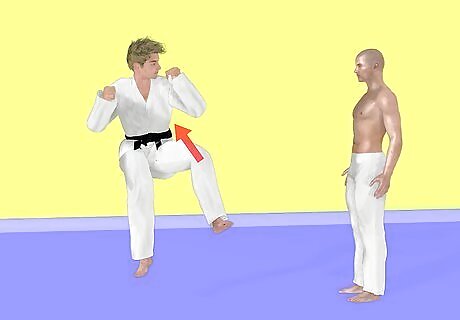
Bring your front knee to your chest as you are jumping. The higher you can bring your knee to your chest, the higher you will be able to kick your target.
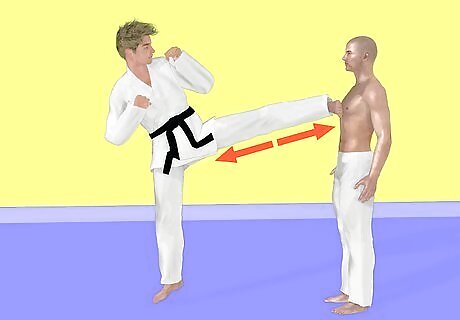
Extend your kick straight out and make contact. You can make contact with either the sole or the heel of your foot. If you are sparring, then it is better to strike with the sole of your foot. If you are trying to break something such as a brick or board you should use the heel of your foot. This way you drive all the strength and force of your kick through your heel, which is the strongest part of your foot.
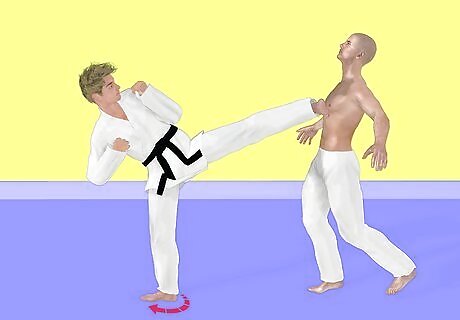
Rotate your non-kicking foot all the way around as you straighten your kicking knee. You will rotate your non-kicking foot until it is facing backwards to gain more power in your kick. As you straighten out the last bit of your knee, rotate your foot to bring the strength of your hip into the kick. This should be the same as the normal side kick.
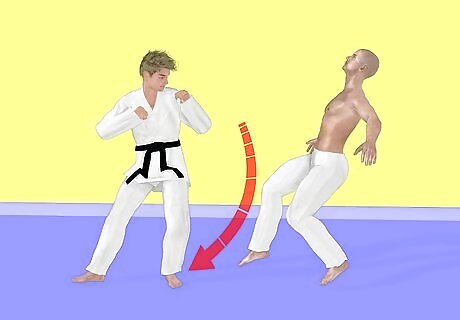
Land with your foot in front of you. Bend your knee and then bring your foot down to the ground. You will land with your foot in front of you rather than bringing it back.
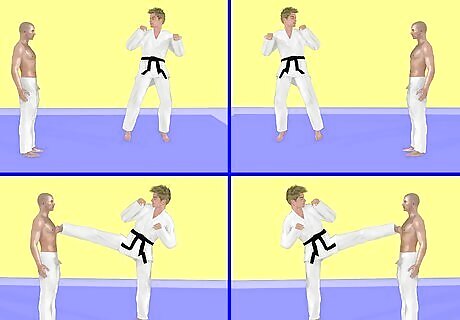
Practice both sides. It is equally important to practice this kick with the other foot as well. Keep practicing often with both legs to develop muscle memory for the kick. This will make it easier and quicker in sparring sessions.
Doing a Reverse Side Kick in Taekwondo
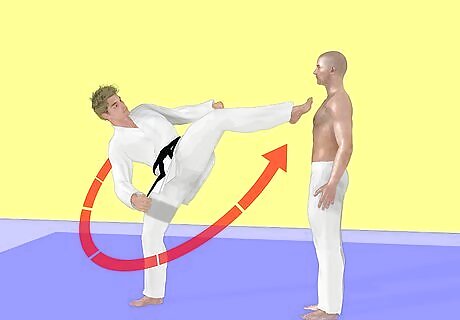
Use the reverse side kick for power generation in competition or practice. This side kick is similar to the normal side kick except there is a spin in it. The reverse side kick is especially useful for sparring or when someone is attacking you because you can do it while fading away from or moving into your target. This kick is also called a spinning side kick.

Start from your fighting stance. You will start from your fighting stance where you have one foot in front and the other behind. Your back hand should be by your chin with your front hand 12-16 inches (30-40 cm) away from your front shoulder.
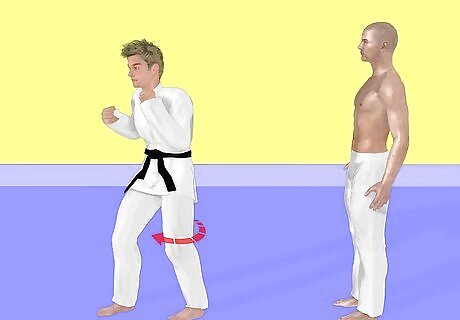
Pre-pivot your front leg. Turn your front foot so that it is pointing behind you or away from your target. This means that you will turn your foot 180 degrees around. You will have to begin turning your hips at the same time as you turn your foot.
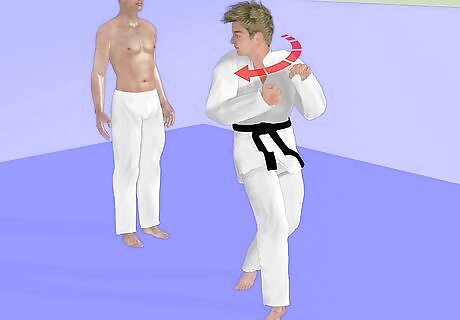
Turn your head over your shoulder to look at your target. Your head should follow the direction of rotation of your foot. This means you will be looking over the shoulder that is on the same side as your kicking foot. For example, if your front foot is your right foot then you turn your right foot so that it is pointed back and bring your head around counterclockwise. You will then be looking over your left shoulder at your target.
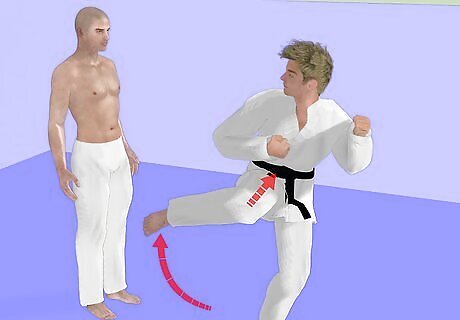
Swing your kicking leg to the front while bringing your kicking knee to your chest. This swing is similar to that of a normal side kick. Bring your back foot around and bend your knee as you rotate your body. Your knee should now be at your chest and there should be a straight line between your hip, heel and the target. For example, if your kicking foot (back foot) is your left foot then you will continue rotating counterclockwise while bringing your left knee to your chest. There should then be a straight line between your left hip, left heel and the target. This is the “spin” of the spinning (or reverse) side kick. This side kick gains additional power from this spin due to the momentum. The smoother and faster your spin is, the stronger your kick will be.
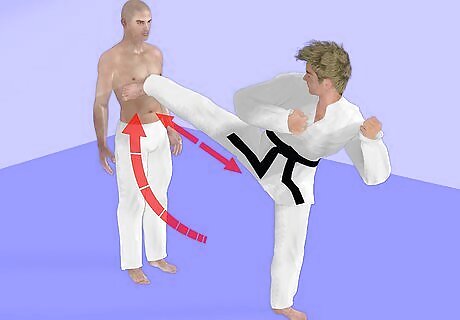
Straighten your knee to strike your target. Straighten the knee to kick out and strike your target. You will usually want to hit at chest height but you can aim for other areas as well. You should strike with the blade (outside edge) of the foot or the heel. These areas will transmit the most power to your target.
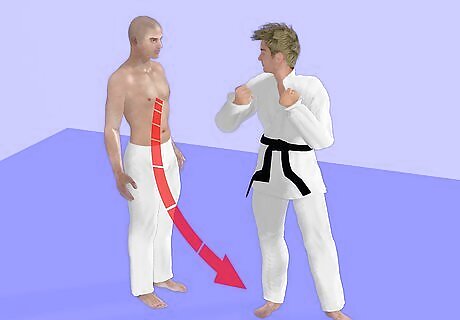
Bend your knee and land back on the ground. Bring your knee back to your chest and then step forward or straight down with your kicking foot. This should bring you back to your fighting stance with the other foot in front compared to when you began the kick.
Doing a Flying Side Kick in Taekwondo
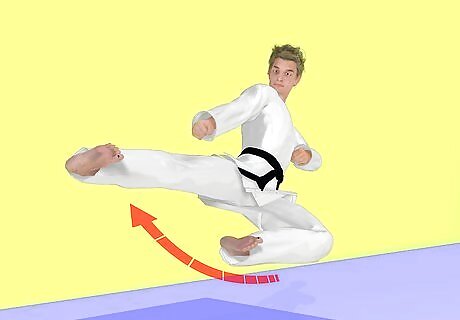
Use the flying side kick to impress your friends. The flying side kick is an advanced technique that is often used for demonstration purposes. If they are done correctly in a fight, they can also be very effective. This is a longer range technique than a regular side kick. The run-up to the kick provides a lot of momentum, making this a very powerful kick.
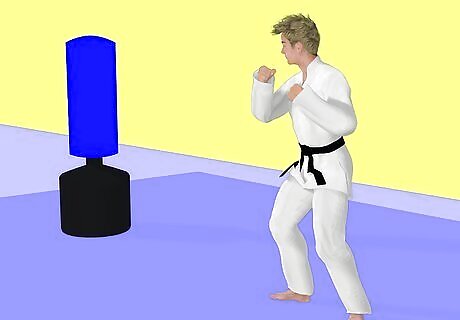
Start from the normal fighting position. A common fighting position is to stand with your left foot in front and right foot in back with your body turned almost all the way to the side. Your right fist will be by your chin with your left 12-16 inches (30-40 cm) from your left shoulder.

Move forward towards your target. If you are kicking a target then you can take one or two steps only but if you are trying to jump over a target then you may need to get a running start for more speed and power.
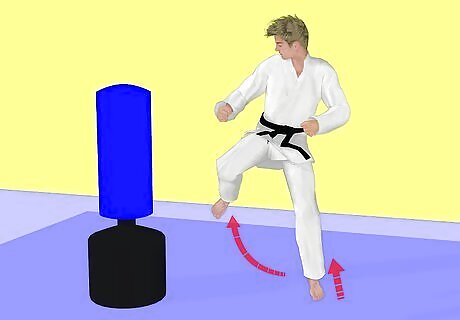
Jump off your non-kicking foot and swing your kicking foot up. Plant your non-kicking foot (the front foot) solidly on the ground and push off of it to get into the air. As you push off turn your body to the side to swing your kicking foot into the front. You should also bring your non-kicking foot up so that your opponent cannot sweep it away from you.
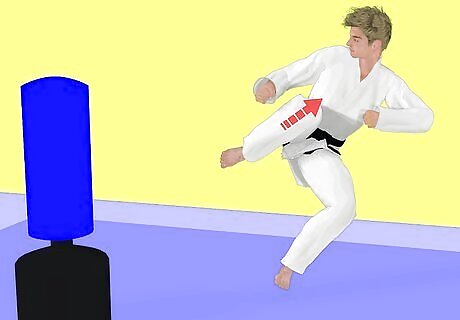
Bring your knee to your chest. While swinging your kicking foot into place be sure to bend your knee up the same as you would do for a normal side kick. This bend of your knee creates a lot of extra power when it is straightened, so keeping your leg straight will lead to a much weaker kick. The farther you bring your knee to your chest, the stronger your kick will be. Keep your heel pointing towards your target.
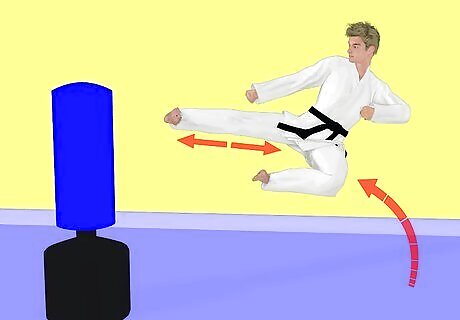
Straighten your knee into contact. Straighten at the very end of the strike. Timing is very important here so you must practice often to learn how to time your kick properly. A lot of your power comes from straightening your knee at the correct time. Be sure you are the right distance from your target to straighten fully but not so far that the kick barely touches the target.
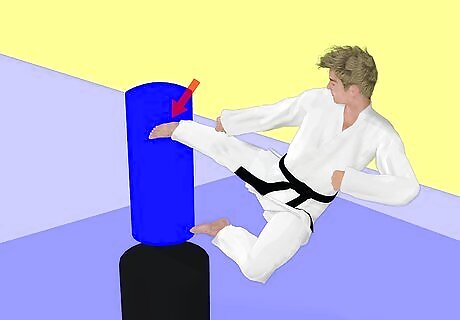
Strike with the blade or heel of the foot. The blade of your foot and heel are the strongest parts of your foot. Your heel is especially strong so if you are going for a knock-out kick then you should strike with the heel for maximum power. Striking with the blade (or outside edge) of the foot is also effective and helps your ankle to absorb the impact of the kick.
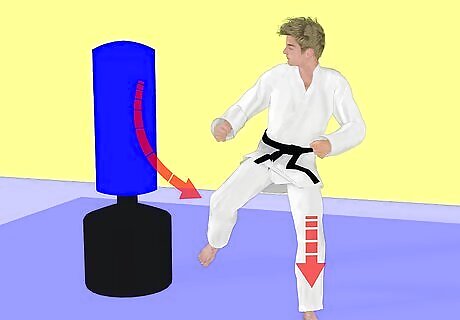
Bend your knee and land. Bring your knee back to your chest and land. You may find it helps to keep turning in the direction of your rotation and go a full circle to get back into the proper fighting stance. Thus if you are kicking with your right foot, then after the strike you can keep turning counterclockwise to complete a full circle and face the target once more. Make sure you land on your feet and stay balanced.
Doing a Side Kick in Kickboxing
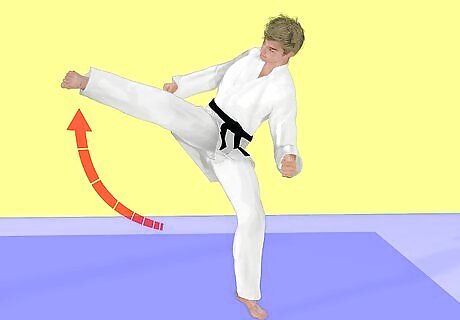
Use the kickboxing side kick for aerobic workouts in kickboxing. The side kick is a great way to burn calories and work up a little sweat and it can be fun too! This is a great kick to add to your kickboxing exercise routine. You can use a punching bag, a partner holding a pad or just shadow kick without anything at all.
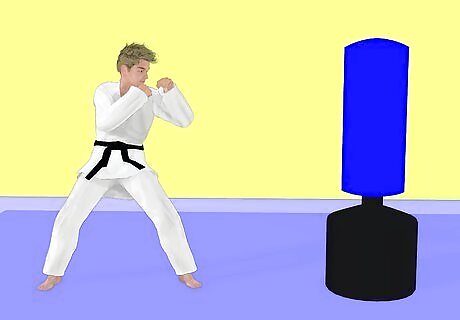
Get in your boxing stance. Your legs should be slightly spread at a bit more than shoulders width with one leg in front and the other in back. Your kicking leg will be in front. Keep your fists up in front of your face. You should practice this with both legs so try it in both directions. After practicing with one leg, switch your stance and practice with the other leg also. Your hands should be in front of your chin and mouth to protect your face. You should be sideways to your target.
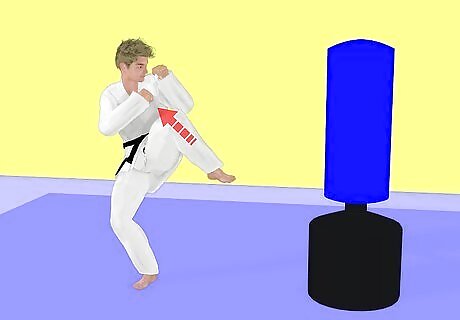
Bring your front knee up to your chest. This bent knee creates the power for your shot so bring it up as high as possible.
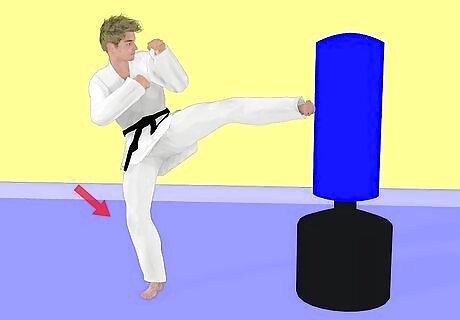
Straighten your knee. Straighten your knee directly forward into contact. You should make contact with the blade, or outside edge, of your foot because it will be stronger and safer for your kick. Make sure you are extending straight forward into contact. This means you will have to be turning your body and hips simultaneously. Think of the kick as a stomping motion to give you extra power and strength. Do not lock out your knee, or extend it completely, or else you could hurt yourself. You will want to maintain a slight bend even when making contact.

Rotate your non-kicking foot. You must rotate your non-kicking foot at the same time to create extra power and strength in your kick. It should end up facing almost completely backwards when you make contact with your target. The non-kicking foot should rotate about 180 degrees so that it faces backwards when you make contact. This rotation is very important so make sure it is moving correctly during your kick. It will feel like you are giving your back to the target because you are rotating your hips into the kick.
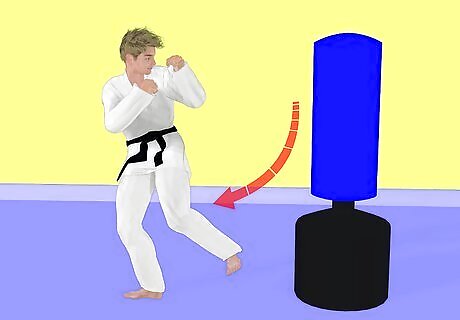
Bend your knee and land forwards. Bend your knee again after contact to bring your knee back to your chest. Bring your foot down to the ground directly in front of you. Your non-kicking foot will have to rotate back to its original position when landing. You can shuffle back after your foot is on the ground to bring you away from your opponent.
















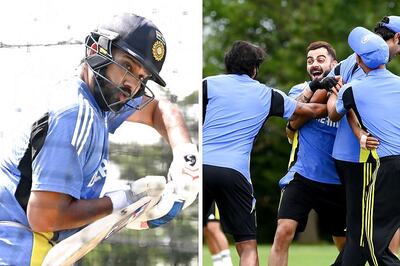
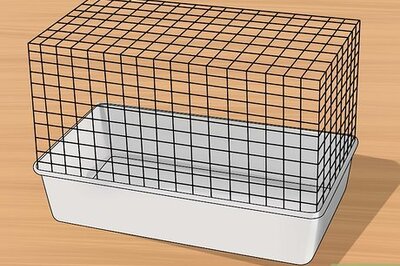

Comments
0 comment